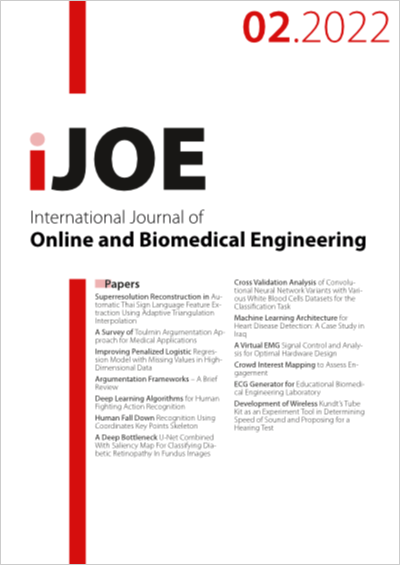Development of Wireless Kundt’s Tube Kit as an Experiment Tool in Determining Speed of Sound and Proposing for a Hearing Test
DOI:
https://doi.org/10.3991/ijoe.v18i02.23267Keywords:
Resonance Tube, Kundt’s Tube, learning mediaAbstract
As a part of contextual learning, laboratory activity supports the physics concept attainment. The everyday physics in real-life occur from the concept of sound, by hearing a sound every day. For further application, the sound wave concept needs to be understood by a particular experiment. For gaining that purpose, this study develops Wireless Kundt's Tube kit. The study has two essential purposes: determining sound speed through the kit and examining the kit as an alternative for a hearing test. The study utilized the ADDIE research design: Analyze-Design-Develop-Implement-Evaluate stages. Specifically, the apparatus bravely brands as wireless Kundt's Tube use Bluetooth connection to integrate the smartphone's central apparatus and have easier accessibility to the students' gadget. This final kit has tried to students in 11th grade of a senior public school in East Java, Indonesia, to demonstrate how to gain their feedback. This kit passed the media and content validity as part of learning media development. The study gained a sound speed of 303.03 m/s and proposed the hearing test's idea as replacing the function of turning fork in a traditional test. It means Wireless Kundt's Tube can apply to the following instruction process as the motivational part for physics learning and a hearing test.
Downloads
Published
2022-02-16
How to Cite
Suprapto, N., Rosyidi, A. I., Mubarok, H., & Adam, A. S. (2022). Development of Wireless Kundt’s Tube Kit as an Experiment Tool in Determining Speed of Sound and Proposing for a Hearing Test. International Journal of Online and Biomedical Engineering (iJOE), 18(02), pp. 200–210. https://doi.org/10.3991/ijoe.v18i02.23267
Issue
Section
Papers
License
Copyright (c) 2022 Nadi Suprapto, Achmad Ichsan Rosyidi, Husni Mubarok, Alif Syaiful Adam

This work is licensed under a Creative Commons Attribution 4.0 International License.



